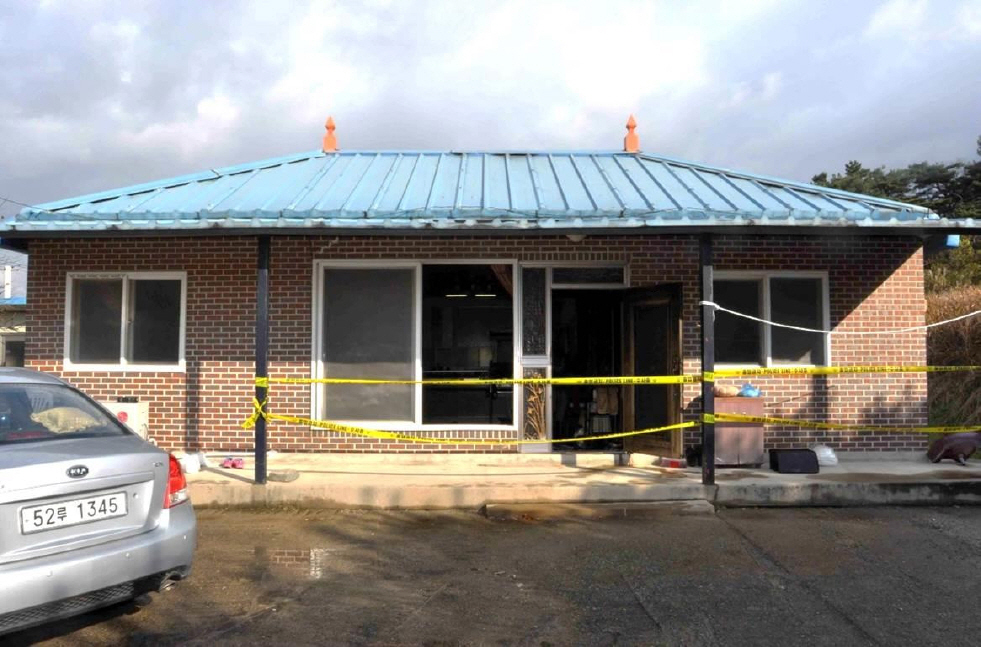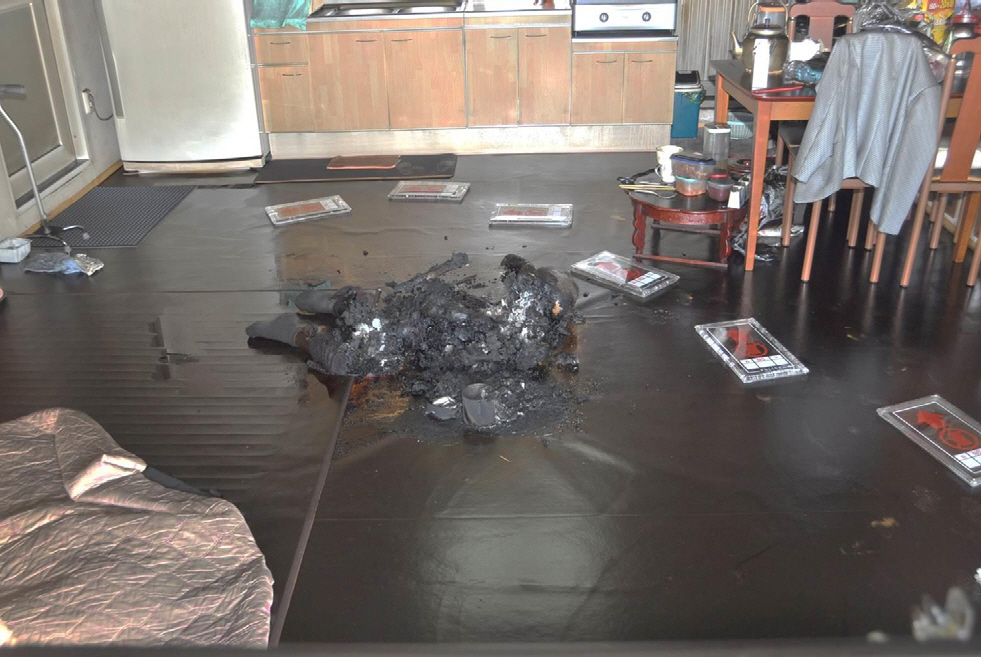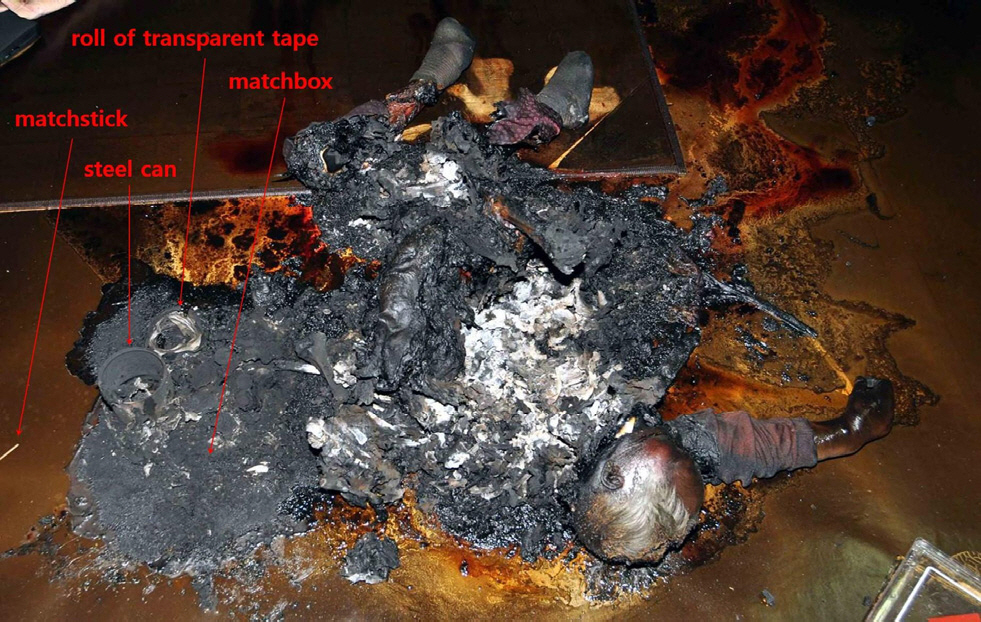외부 점화원에 의한 여성 신체의 연소
Combustion of a Female Body Due to an External Ignition Source
Article information
Abstract
요 약
2013년 11월 한국의 농촌 주택에서 발생한 여성 신체의 지속적인 연소 사례가 제시된다. 여성의 신체 중 무릎에서 목 부분까지는 거의 완전하게 소각되었고 머리, 팔, 무릎 아래의 다리 및 발은 거의 연소되지 않은 상태로 발견되었다. 외부 점화원으로는 성냥에 의한 불씨가 가장 유력했다. 거실 바닥에서 발견된 할머니만 주로 연소되었으며, 주택 안에 있는 다른 사물들은 검갈색의 기름이 묻은 것처럼 또는 기름으로 코팅된 것처럼 보였으며 사실상 거의 연소되지 않았다. 변사자의 타지 않은 의류 및 양말에서 인화성 물질이 검출되지 않았으며, 근육 조직에서 약독물 성분 또한 확인되지 않았다. 말초 혈액의 혈중일산화탄소-헤모글로빈 농도는 11%, 안방수의 에틸알콜농도는 0.010% 미만이었다. 부검 결과 탄화가 고도로 진행되어 사망원인을 단정하기 어려웠다.
Trans Abstract
ABSTRACT
In November 2013, a case of sustained combustion of a female body was encountered in a Korean farming village. The body was almost completely incinerated from the neck to the knees, and other parts of the body, such as the head, arms, lower legs, and feet, were slightly damaged. The most likely external ignition source was the flame from a matchstick. The elderly woman was found incinerated on the floor of the living room, while other objects in the house were largely undamaged except for having a brown oily or greasy coating. Flammable substances were not detected from the woman’s intact pieces of clothing and socks, and her muscular tissues did not contain toxic chemicals. The concentration of carboxyhemoglobin in her peripheral blood was 11% and that of ethyl alcohol in her aqueous humor was below 0.010%. An autopsy failed to determine the exact cause of death because of excessive charring.
1. Introduction
When a human body is discovered with the head, arms, lower legs, and feet mostly intact, and the chest, abdomen, and upper legs are extensively damaged, this is sometimes mistakenly perceived as spontaneous human combustion. Cases of spontaneous human combustion have been reported in the last century and past decades, and common features identified in the literature are as follows(1-4).
Chest, abdomen, pelvis, genital area, and upper legs are extensively damaged, while the head, arms, lower legs, and feet are mostly intact.
There is no clear source of ignition, and the fire appears to have occurred spontaneously in the victim’s vicinity.
The surroundings are mostly intact, and combustion is limited to the body, clothes, and objects in contact with the body.
The fire is discovered after being extinguished on its own when relatives, friends or neighbors notice smoke or smell and come to search for victims.
To understand the above, DeHaan and co-workers(5,6) researched on the combustion of animal fat (Pork) under various conditions. They found that animal fat, which is highly similar to human body fat, can serve as the fuel of a compartment fire. The following conditions must be satisfied for the combustion of animal fat.
- Presence of a charred porous substrate that functions similarly to a kerosene lamp or candlewick.
- Presence of an external ignition source that lasts for the time needed to char and split the human skin, followed by the release of subcutaneous fat.
Animal and human tissues can undergo combustion in a localized fire due to the absorption of fat into a charred porous substrate, and burn naturally over a long period or time. This paper presents a case of sustained human body combustion that exhibits the key features of past cases.
2. Case Report
At around 08:40 on November 19, 2013, a caregiver visited the house of an elderly woman, aged 80. There were no signs of anyone being in the house, so the caregiver called a locksmith to open the door. The elderly woman lived in a typical house in a Korean farming village (Figure 1). Judging from the intact exterior, it was impossible to conceive that the woman had been burnt to death.
Upon opening the door, the caregiver was shocked by the charred body(Figure 2, 3) of the elderly woman on the floor of the living room, and immediately called the police.
The elderly woman suffered from hypertension and diabetes and had poor mobility. She lived alone in the house. Recently, she had nightmares about her husband’s ex-wife, who had passed away three years earlier. She occasionally mentioned wanting to drink pesticide to end her life. The house comprised a kitchen, bathroom, large bedroom, a small bedroom, and a living room. The surroundings of the charred body were intact. The body was severely consumed from the knees to neck, but the head, lower legs, feet, and right hand were hardly damaged. The bones, including the ribs and vertebrae, were in the form of grey powder. Her feet, with socks on, were intact, and her lower legs were placed on the electric mat.
On the floor next to the old woman’s left arm were an intact matchstick, a burnt matchbox, an empty steel can, a roll of transparent tape, and supplies for pressure ulcer prevention. The most significant damage to the flooring material occurred around the left arm, near the matchbox. According to police investigations, the elderly woman did not smoke, and cigarettes were not found in the house.
Except for the floor beneath the body and the area near the matchbox, the other objects in the house were largely undamaged except for a brown oily or greasy coating. All the windows were closed.
The charred body was moved to a forensic center for further analysis and recorded a weight of 12 kg. Based on external examination alone, gender identification was not possible because of excessive charring.
There was no evidence of fractures in intact body parts, including the skull. Most of the torso was charred and deformed, making it difficult to examine the internal organs. Toxicological analyses on muscular tissues showed no traces of cyanide, organic phosphorous, organic chloride, carbamate, benzodiazepine derivatives, phenothiazine derivatives, salicylic acid derivatives, or alkaloid. The concentration of carboxyhemoglobin in peripheral blood was 11%, and that of ethyl alcohol in aqueous humor was below 0.010%. Flammable substances were not detected from the woman’s clothes, socks, or flooring material near the matchbox.
The cause of death was difficult to determine forensically because of the large area of sustained damage to the body.
3. Discussion
The case reported herein excludes the possibility of the fire being caused by an intruder trespassing on the property. The only source of ignition found near the charred body was the matchbox. Taking into consideration that the elderly woman mentioned having nightmares and wanting to end her life by drinking pesticide, the fire can be traced to flames from the match (Intentional or by accident), with the clothes serving as fuel for combustion.
According to experiments by DeHaan and co-workers(5,6), the human skin can char and release melted subcutaneous fat when exposed to an external ignition source of 10-15 min or longer. If the fat can be absorbed into a porous charred substance that can act as a wick, the flames can last until the fat is consumed (Wick effect).
The combustion mechanism of this case is believed to be similar to that suggested by DeHaan and co-workers. The modest external ignition source (Match) would have burnt the clothes covering a specific body part. From there, the skin would have split, and released subcutaneous fat. The subcutaneous fat would have been absorbed into the porous clothes and fuelled the combustion until completely consumed.
Acknowledgements
This work was supported by National Forensic Service (NFS2020FSA02), Ministry of the Interior and Safety, Republic of Korea.


